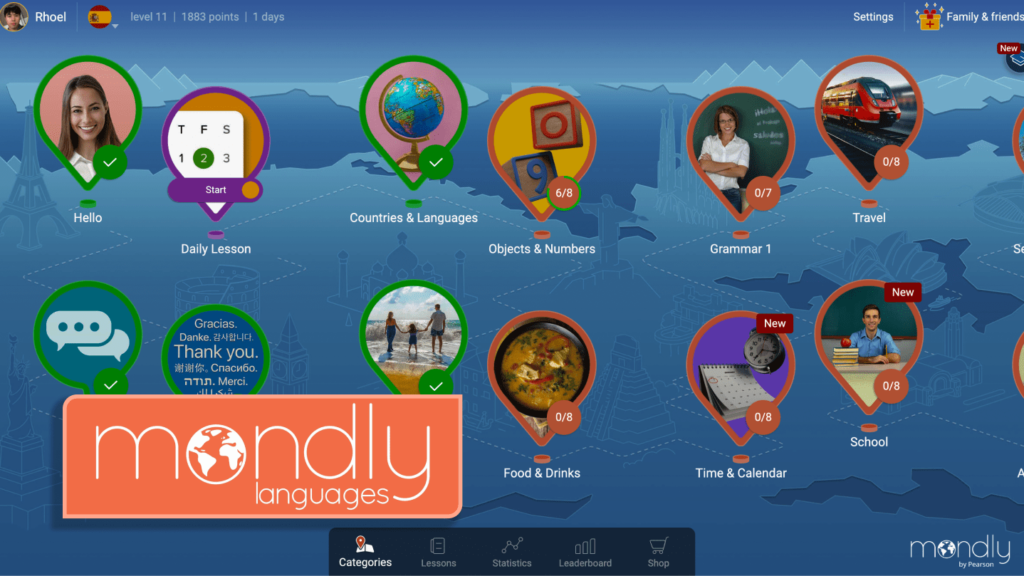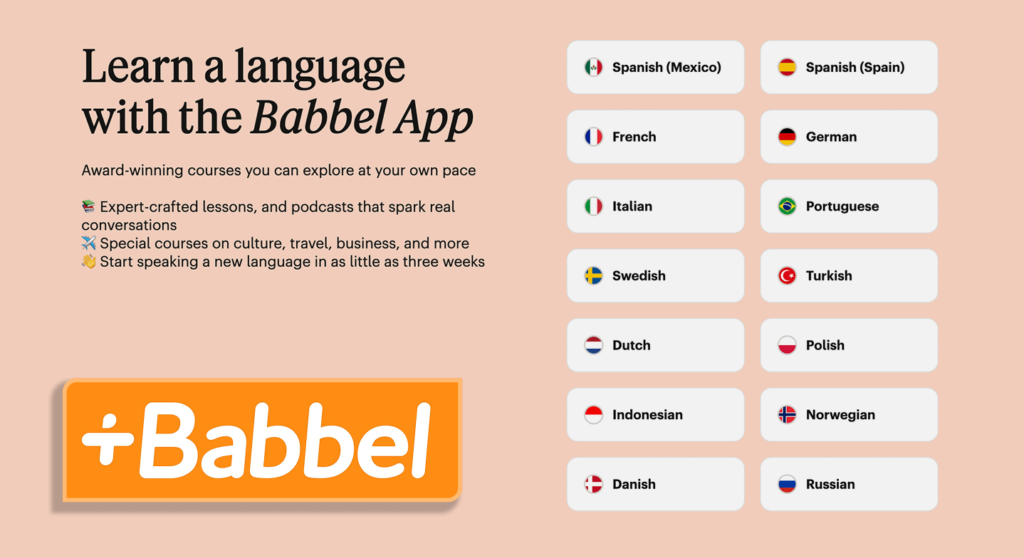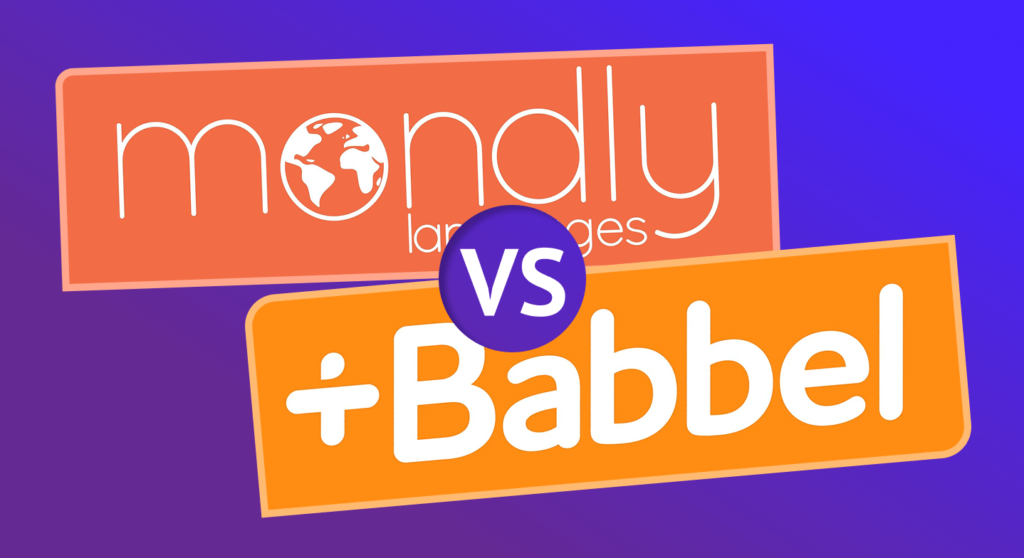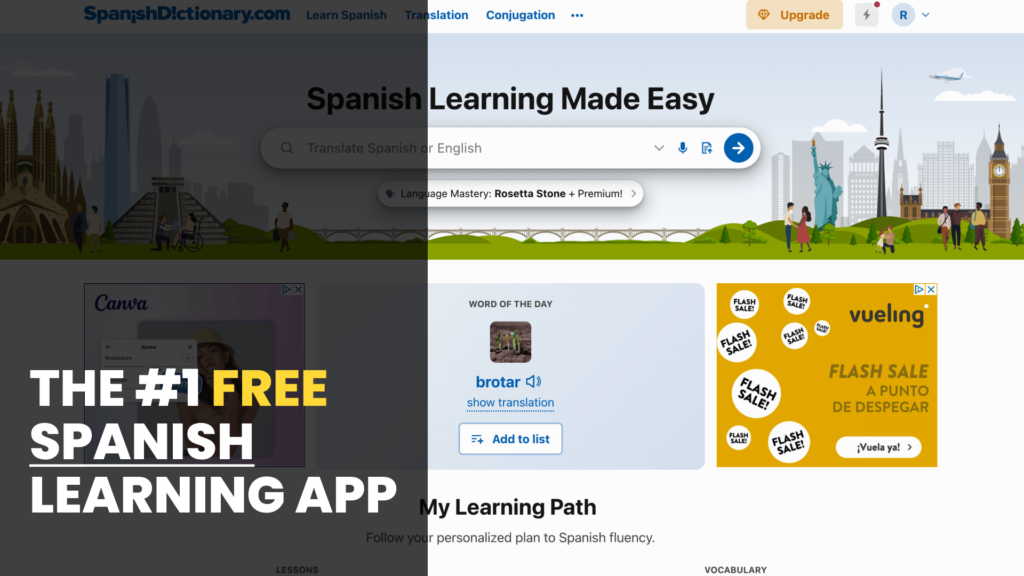First, What Do You Really Want From a Language App?
There are dozens of language learning apps out there — all promising to help you improve whatever language you’re trying to learn. But here’s the thing: when you have too many options, you can end up stuck, not knowing which one to choose. It’s called decision paralysis, and I’ve been there.
That’s why it’s important to narrow your focus. Instead of comparing every tiny feature, ask yourself: What should matter to me as a beginner?
After years of learning Spanish — and trying way too many apps — here are the things I wish I had paid attention to before paying for a subscription. If you’re deciding between Mondly VS Babbel, here´s a personal list that helped me choose the one that really worked for me.
Mondly
Mondly offers a wide variety of topics, but some of the phrases feel random or unnatural — like they were pulled straight from a grammar book. I came across sentences that were (well…) technically correct, but honestly not that useful if you’re just starting to learn a language.
Babbel
Babbel sticks to real-life conversations. From the beginning, you get practical phrases you can actually use in everyday life — from introducing yourself, ordering food, to asking for help. It feels like you’re preparing for actual conversations, not just memorizing random examples.
Winner: Babbel
2. Do you want to actually remember what you learned a week, a month, or a year from now?Mondly
When I was using Mondly, I noticed that once I finished a lesson, that was pretty much it. If I wanted to review something, I had to go look for it myself. There was no system in place to help bring things back at the right time — and honestly, a lot of what I learned just slipped away. It felt like I was constantly relearning things I’d already studied.
Babbel
With Babbel, it was a different story. The app has a built-in review section that uses spaced repetition. Basically, it brings back words and phrases just before you’re about to forget them — which is exactly what I needed. I didn’t have to think about reviewing, it just became part of the process. And because of that, I started remembering things longer, even weeks later. That made me feel like I was actually making progress.
Winner: Babbel
3. Do you want a bit of grammar support, just enough to help you pick up language patterns?Mondly
Mondly, unfortunately, didn’t really teach me grammar. It felt like I was just supposed to “absorb” everything without understanding how or why it works. I often found myself confused about certain phrases or sentence structures — and when I made mistakes, the app didn’t explain what I did wrong. It left me guessing, which wasn’t helpful as a beginner.
Babbel:
Babbel includes grammar explanations throughout the lessons, so you start to understand the patterns behind what you’re learning. It also has a grammar drill section where you can practice specific structures — like personal pronouns, the present continuous, reflexive verbs, and more.
That said, I do find Babbel’s grammar explanations a bit too basic. If you’re a beginner, it’s enough to get you going. But as you progress, you’d definitely need other resources that explain things in more depth.
Winner: Babbel — though it still has room to improve.
4. Do you want to actually practice speaking, not just tap through lessons and move on?Mondly
I actually enjoyed Mondly’s hands-free mode. It teaches you phrases and lets you repeat them back while the voice recognition checks if you said it right. The best part? I didn’t have to be glued to my phone. I could do chores while studying Spanish — and that made me feel really efficient.
My only issue with it is that the phrases stay very basic — things like introducing yourself, ordering food, or simple greetings. It kind of felt like something out of Dora the Explorer. That might be fine if you’re planning a short trip and be a tourist, but it won’t get you conversational.
Babbel
Babbel includes a Guided Conversations section where you’re given a script. First, you listen to the full conversation, then you get to speak your part. The voice recognition checks if you said it right, which makes it feel more interactive. The topics are practical and varied, from “Talking to your new partner about your family” to “Buying a bicycle for your child.”
It also has an AI Conversation Partner, where you’re asked to complete speaking tasks during the interaction — something like talking about your habits, routines, or using adverbs of frequency. I really liked this feature because it gave me space to freestyle a bit. I wasn’t just repeating lines; I had to find my own words and express myself using the Spanish I already knew. It challenged me, but in a good way.
Honestly, I’m impressed with these features. They’ve helped me explore new ways to express myself in Spanish — things I can actually use in everyday life.
Winner: Babbel
5. Do you want a clear learning path that shows real progress, not just random lessons with no direction?Mondly
Mondly does say it’s CEFR-aligned, but quite frankly, I didn’t really feel that structure while using it. The levels are simply labeled beginner, intermediate, and advanced — and even though it claims to teach up to B2, a lot of the lessons still felt beginner-level (A2) to me.
To be fair, it does give you a visible path so you can track your progress. But I wasn’t fully confident in the structure it provided. It looked organized, but I don´t think it follows the CEFR framework.
Babbel
Before you even start learning with Babbel, it asks you to take a quick placement test to check your current CEFR level. Once it knows where you’re at, it recommends lessons that are suited to your level — so you’re not starting too easy or jumping ahead too fast.
What I also liked is that the lessons are clearly divided by CEFR levels, from Newcomers (A1) all the way to Advanced (C1).
Winner: Babbel
6. Do you need motivation to stay consistent, even on the days you don’t feel like studying?Mondly
Mondly has a clean, colorful design that’s actually fun to look at. I personally enjoy the visuals and sound effects — they make the experience more engaging. It also has reminders and streaks to help you stay on track.
The lessons are short, usually 5–8 minutes, which really helps because I don’t feel like quitting halfway through. It even tracks how many words and phrases you’ve learned, and seeing that number grow is honestly pretty motivating.
Overall, I think Mondly can do a good job of helping you stay consistent in your language learning journey because of how gamified it was structured.
Babbel
Babbel also has reminders and progress tracking, plus it shows you how many words and phrases you’ve already learned — which is nice to look back on. But I’ll be honest: some lessons felt a bit too long for me, around 20 to 30 minutes. I think they could’ve split some of those into shorter parts so it wouldn’t feel so drawn out.
Visually, Babbel has a more modern and minimalistic design — from the colors and images down to the font style. It’s definitely not gamified. I’d say Babbel is designed more for serious learners. If you haven’t built a solid study habit yet, or if sticking to routines is tough for you, it might be harder to stay consistent with Babbel.
Winner: Mondly
Special Features

Mondly
- Hands-Free Mode: Lets you learn and repeat phrases out loud while doing other tasks. Great for multitasking (e.g., learning while doing chores).
- Voice Recognition: Checks your pronunciation as you repeat phrases — helps with improving your pronunciation.
- Augmented Reality (AR) Lessons (available on some devices): Learn through interactive scenarios where virtual objects or tutors appear in your real-world space.
- Chatbot Conversations: Simulated dialogues with a chatbot to help you practice conversational flow.

Babbel
- Grammar Guide: Drills on grammar structures — like using personal pronouns, reflexive verbs, or forming the present continuous. It doesn’t just explain; it gives you space to practice.
- Guided Conversations: Listen to and practice full conversations, speaking your part with voice recognition support.
- AI Conversation Partner: Interactive speaking drills where you’re tasked with completing prompts that challenges you to actually use what you’ve learned.
- Spaced Repetition System (SRS): Daily vocab workout so you don´t forget what you previously learned.
- Podcasts + Cultural Tips (Bonus Materials)
Extra content for immersion, especially helpful once you hit beginner–intermediate level.
Comparison Table: Mondly VS Babbel
For quick skimming remember:- ✅ Yes / Strong: This feature is available and works well.
- ⚠️ Limited / Needs improvement: The feature exists but isn’t very effective or could be better.
- ❌ No / Not included: This feature is missing or not supported at all.
|
What Matters |
Mondly |
Babbel |
|---|---|---|
|
Real-life phrases you’ll actually use |
⚠️ Some random or odd phrases (“The panda does not speak…”) |
✅ Practical, everyday conversations you’ll actually need |
|
Helps you remember what you learn (SRS) |
❌ No built-in spaced repetition |
✅ Built-in review with spaced repetition system |
|
Easy grammar explanations & drills |
❌ No formal grammar instruction |
✅ Yes — beginner-friendly grammar tips & drills |
|
Clear path with CEFR structure |
⚠️ Basic labeling (Beginner/Intermediate) |
✅ Full CEFR-aligned (A1–C1) with placement test |
|
Speaking practice that feels useful |
⚠️ Repeating basic lines; limited interaction |
✅ Guided and AI-led conversations to express yourself |
|
Motivates you to stay consistent |
✅ Gamified, short lessons, fun visuals |
⚠️ More serious tone; less gamified |
|
Pricing |
✅ Cheaper; lifetime option available |
⚠️ More expensive, but deeper features |
|
Best for… |
Casual, visual learners or travelers |
Adult beginners serious about long-term progress |
Honest Verdict: Mondly vs Babbel
Mondly is a language learning app that is fun, visual, and easy to use. If you’re just starting out, want to learn basic phrases, or you’re planning a short trip to a Spanish-speaking country — it can definitely help.
As an adult who moved in Madrid, I’m not just learning Spanish for fun — I want to actually communicate, connect, and live fully here. That means I need a language app that goes beyond cute animations and teaches me how the language works and how to use it in real situations.
Babbel gives me that. It’s not flashy, but it’s structured. It follows CEFR levels, includes speaking tasks that push me to express myself, and it helps me build real, usable Spanish. It’s not perfect, and sometimes the lessons are longer than I’d like — but it supports my goals as a serious learner.
So, my verdict?
If you’re just dipping your toes into language learning and want something lightweight and easy — go for Mondly. Curious about Mondly? Give it a free spin and see how it feels.
But if you’re like me — living abroad, or truly committed to learning the language — Babbel is the better choice. Want to try Babbel for free? Start your free lesson here.
Recommended Reads:


